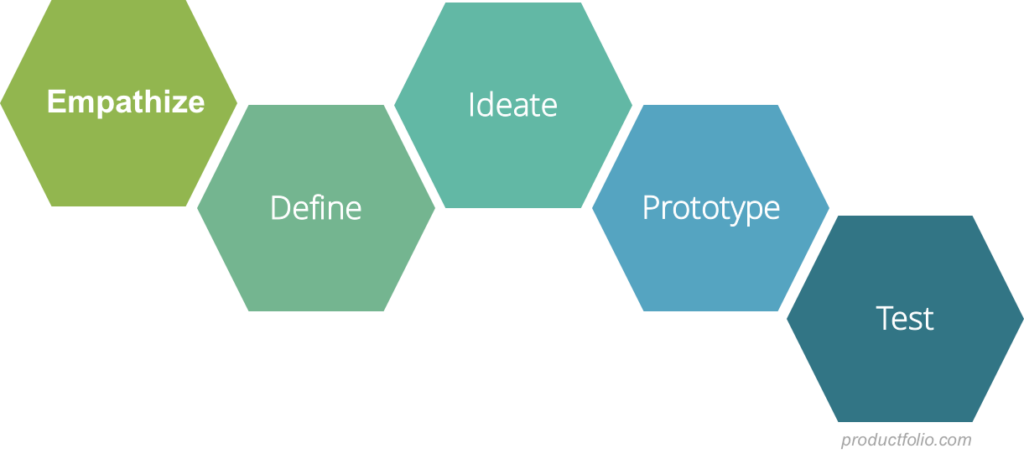What is Design Thinking?
Design thinking is a high-level framework that has become popular recently for people to apply design principles to solving other types of problems. The principal concept is that you identify the customer you’re designing for, empathize and understand their problems, and then design a solution specific to those needs. The fundamental ideology of design thinking is that it is human-centric, with the assertion that a hands-on, user-centric approach will lead to innovation which leads to differentiation which ultimately provides a competitive advantage.

The term Design thinking was coined in the 1990s by the Kelley brothers, David and Tom and Tim Brown of IDEO. Though Design Thinking was embraced into a broad spectrum of company cultures in the 1990s, the Human-Centric revolution of Design Thinking began in the 1960s when professions like Product Design and Industrial Design began to separate themselves from engineering and sciences and focused on the human-centric approach to design. Today, Design thinking is applied to all areas of business from architecture, to Product Management.
Design thinking is user-centric, focusing first and foremost on humans’ needs and desires. The goal with Design thinking is to determine a user’s problems and to find effective ways to solve those problems, often referred to as a solution-based approach to problem-solving. Let’s take a look at the phases of Design thinking and how to integrate it into Product Management.
What are the 6 Phases of Design Thinking?
Empathize
Empathy is a critical starting point for Design thinking. In this phase, it’s important to spend time with the user(s) and to understand their needs from a physiological and emotional level. It’s important to gain insights by setting aside assumptions and focusing on the users’ needs, desires and objectives which can only be done by observing and engaging with the user in real-time.
Define
The next stage of Design thinking is defining the problem. By spending time with the user in the empathy stage you will naturally discover where their pain points are, and you will see what problems the user needs solving. Organize all of the observations that you experienced while engaging one on one with the users and see if there are any unmet needs that can be fulfilled.
Ideate
Now that the users’ unmet needs have been defined as well as their pain points, it’s time to get creative and find solutions. This is where the brainstorming begins. Get together with the team and be as creative as possible.
Prototype
In this phase, you put all of your ideas to the test to see which ideas are feasible in the real world. Make your prototype tactile with a wireframe and iterate as many times as necessary until you have a viable working prototype.
Test
Test out your prototype by determining if it fulfills the needs of the previously gathered user feedback. Have you relieved the previously noted pain points? Were you able to fulfill the previously discovered unmet needs? You will need to go back through the process until you determine that the pain points are relieved and the users’ needs are met.
Implement
Just as it sounds, implement your product into the market. Ensure that your users’ needs are met and they are satisfied.
The 6 phases of Design thinking are not linear and are meant to be used as a guideline, a good starting point. Each phase is meant to be iterative and cyclical as opposed to a strictly linear process, see it as an adaptable framework and adjust as needed. It’s very common to revisit the stages after the Product has been tested in the market. Often it’s not until a product comes to life that you can see where the tweaking needs to take place. This is the best time to revisit the Empathize and Define phase
What is a “wicked problem” ?
A “wicked problem” is a problem that does not have a definitive solution.
It’s a problem that needs to be solved but is tricky because oftentimes a new problem will arise just as one of the problems is solved. Another telltale sign that it’s a “wicked problem’ is that there is no stopping point or it is ambiguous in nature. Often times with a “wicked problem”, it’s an ongoing process with no end in sight. Climate change is a great example of a “wicked problem”.
How do Lean and Agile apply?
Design thinking is a human-centered model that solves problems in the marketplace. Once you find a solution to the pain points of the users you’ll work with lean principles—iterating, gathering quick data and feedback to see what works, while working with your team. With Agile you’ll be doing short sprint cycles, allowing for adaptability and readiness for change.
Benefits of Design Thinking
The principal goal of Lean is to ‘reduce waste’ by identifying a solution that resonates with the audience as efficiently as possible. When possible that often means working in small batches and seeking feedback early and often. Combining Design Thinking and Lean principles can be a powerful method of finding product-market fit quickly, as described in books like The Design Sprint.
Since Design thinking is a user-centric approach you’re likely to increase customer retention and user engagement. One of the pitfalls that Product Managers can fall into is focusing on the organization and their internal needs and goals. Design thinking forces a PM to focus first on users needs and desires. Additionally, it keeps the focus on solving the users’ problems as opposed to focusing on the product itself. Lastly, this approach also encourages innovation as well as cross-team collaboration.


